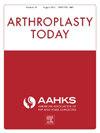髋关节置换术后血液中的金属离子水平:两种不同植入物的比较
IF 1.5
Q3 ORTHOPEDICS
引用次数: 0
摘要
背景虽然髋关节置换术已被证明是治疗终末期骨关节炎的有效假体解决方案,但之前的研究也报告称,使用金属关节后,血液中的金属离子水平越来越令人担忧。本研究的目的是比较使用伯明翰髋关节置换术(BHR)植入系统和 ReCap Magnum 治疗的患者的早期和中期血液金属离子水平、功能预后和植入物存活率。方法回顾性研究确定了 2006 年至 2018 年期间在一家机构使用 BHR(n = 67)和 ReCap(n = 67)进行了 134 例髋关节置换关节置换术的 104 名患者。ReCap和BHR患者按性别、股骨头和髋臼杯尺寸、年龄和手术年份1:1配对。研究的主要结果是钴离子(Co)和铬离子(Cr)水平。结果ReCap队列与BHR队列相比,1-2岁时的金属离子水平中位数较低(Co:1.5 vs 1.9 parts per billion [ppb],P = .018;Cr:1.3 vs 2.8 ppb,P = .018):手术后 1-2 年(Co:1.5 vs 1.9 十亿分之一 [ppb];Cr:1.3 vs 2.8 十亿分之一,P = .008)和 3-5 年(Co:1.1 vs 1.9 十亿分之一,P = .001;Cr:1.2 vs 2.2 十亿分之一,P = .003),与 BHR 队列相比,中位金属离子水平较低。相关性分析表明,Co 和 Cr 离子水平与术前和术后患者报告的结果之间没有明显关联。各组的翻修指征不同。结论BHR患者在术后1-2年和3-5年的金属离子水平高于ReCap患者,但这些金属离子水平仍然较低,与之前的研究结果一致。BHR和ReCap患者的翻修指征不同。外科医生在向患者提供有关这些金属对金属关节的咨询时应注意这些结果。本文章由计算机程序翻译,如有差异,请以英文原文为准。
Blood Metal Ion Levels After Hip Resurfacing: A Comparison of 2 Different Implants
Background
While hip resurfacing arthroplasty has been shown to be an effective prosthetic solution for end-stage osteoarthritis, prior studies have also reported an increasing concern regarding blood metal ion levels following the use of metal-on-metal articulations. The purpose of this study was to compare early and midterm blood metal ion levels to functional outcomes and implant survivorship for patients treated with the Birmingham Hip Resurfacing (BHR) implant system and the ReCap Magnum.
Methods
A retrospective review identified 104 patients who underwent 134 hip resurfacing arthroplasties using BHR (n = 67) and ReCap (n = 67) at a single institution between 2006 and 2018. ReCap and BHR patients were matched 1:1 by sex, femoral head and acetabular cup sizes, age, and year of surgery. The primary outcome of interest was cobalt (Co) and chromium (Cr) ion levels.
Results
The ReCap cohort had lower median metal ion levels compared to the BHR cohort at 1-2 y (Co: 1.5 vs 1.9 parts per billion [ppb], P = .018; Cr: 1.3 vs 2.8 ppb, P = .008) and 3-5 y (Co: 1.1 vs 1.9 ppb, P = .001; Cr: 1.2 vs 2.2 ppb, P = .003) after surgery. Correlation analysis showed no significant associations between Co and Cr ion levels and pre- and postoperative patient-reported outcomes. Indications for revision differed between groups. Three BHR hips were revised due to adverse reactions to metal debris, whereas 2 ReCap hips required revisions: one for instability and another for periprosthetic fracture.
Conclusions
BHR patients had higher metal ion levels than ReCap patients at 1-2 and 3-5 y after surgery, though these metal levels are still low and in line with prior studies. Indications for revision differed between patients treated with BHR and ReCap. Surgeons should be aware of these outcomes when counseling patients regarding these metal-on-metal articulations.
求助全文
通过发布文献求助,成功后即可免费获取论文全文。
去求助
来源期刊

Arthroplasty Today
Medicine-Surgery
CiteScore
2.90
自引率
0.00%
发文量
258
审稿时长
40 weeks
期刊介绍:
Arthroplasty Today is a companion journal to the Journal of Arthroplasty. The journal Arthroplasty Today brings together the clinical and scientific foundations for joint replacement of the hip and knee in an open-access, online format. Arthroplasty Today solicits manuscripts of the highest quality from all areas of scientific endeavor that relate to joint replacement or the treatment of its complications, including those dealing with patient outcomes, economic and policy issues, prosthetic design, biomechanics, biomaterials, and biologic response to arthroplasty. The journal focuses on case reports. It is the purpose of Arthroplasty Today to present material to practicing orthopaedic surgeons that will keep them abreast of developments in the field, prove useful in the care of patients, and aid in understanding the scientific foundation of this subspecialty area of joint replacement. The international members of the Editorial Board provide a worldwide perspective for the journal''s area of interest. Their participation ensures that each issue of Arthroplasty Today provides the reader with timely, peer-reviewed articles of the highest quality.
 求助内容:
求助内容: 应助结果提醒方式:
应助结果提醒方式:


